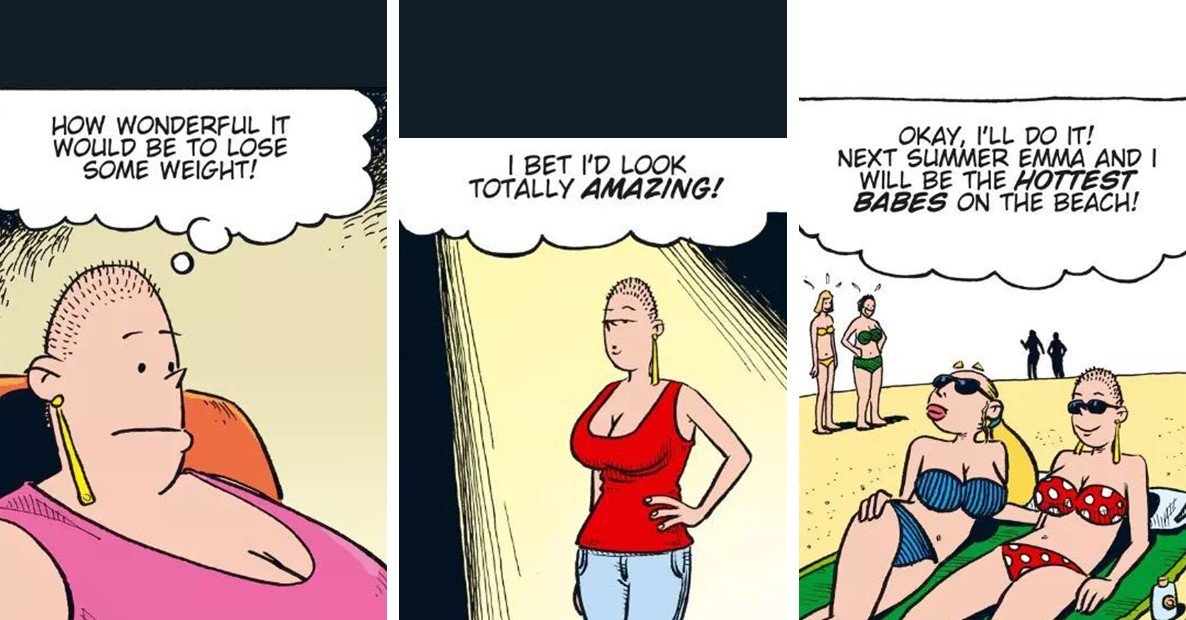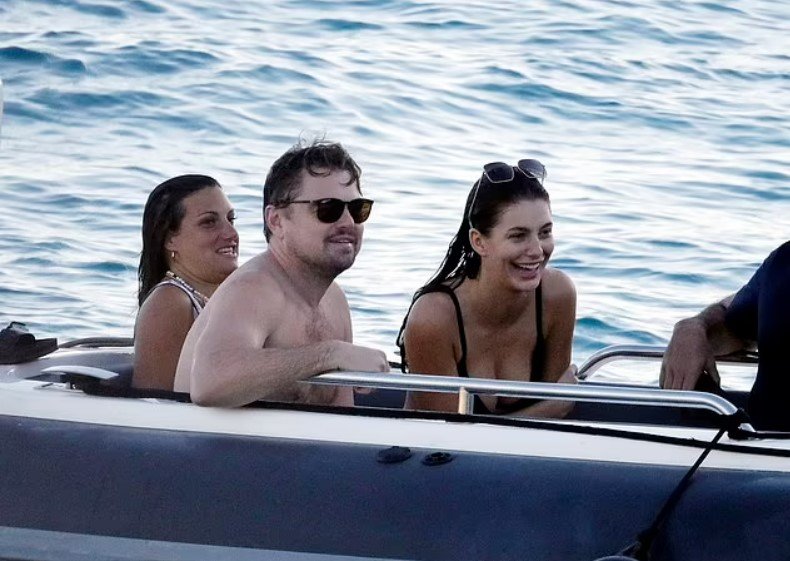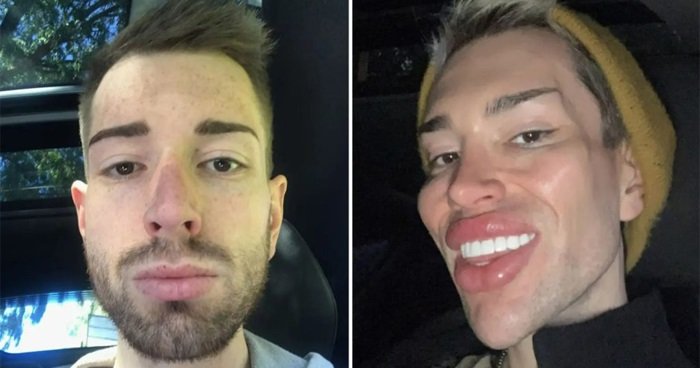#31 "Witness" By Emily Garthwaite, Uk, Highly Commended 2018 Wildlife Photojournalism
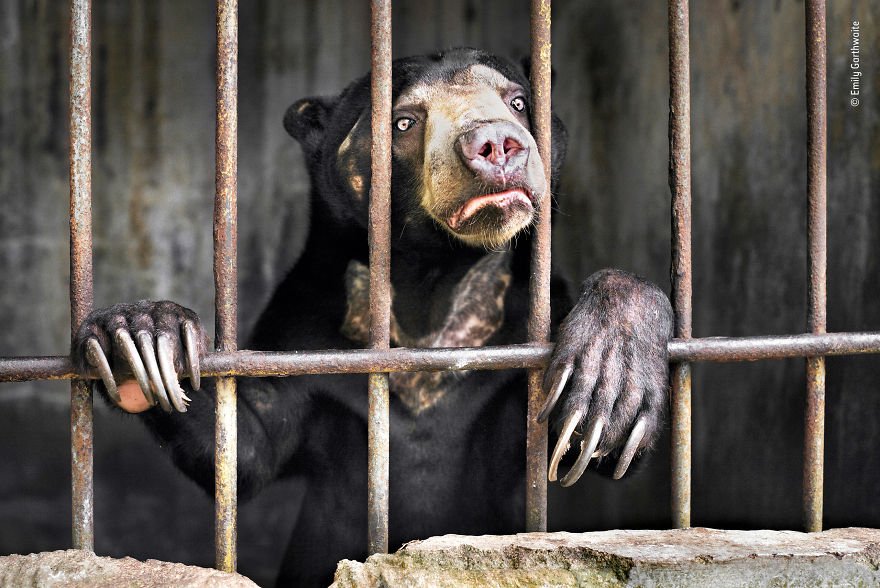
-Via
When Emily approached, the young sun bear hurried to the front of its filthy zoo cage, seemingly eager to interact with her. Yet when it spotted its keeper, its demeanour changed. As the keeper poked and provoked the bear ‘he started screaming,’ said Emily. ‘I’ve never heard such an awful noise, it was very frightening.’ Sun bears are the world’s rarest bears, yet are commonly exploited for their gall bladders and bile. In traditional Chinese medicine the bile is thought to treat a range of ailments, from hangovers to hepatitis. Cubs are farmed, sometimes living permanently with a catheter used to drain the bile.
#32 "The Sad Clown" By Joan De La Malla, Spain, Winner 2018 Wildlife Photojournalism
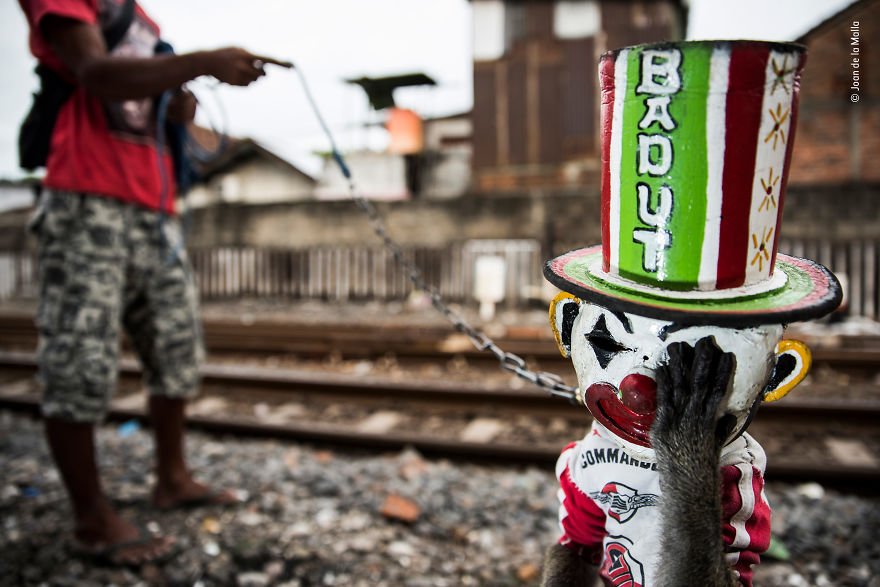
-Via
Timbul, a long-tailed macaque, puts his hand to his face to try and relieve the discomfort of his mask, while being trained to stand upright for a street show. Sights such as this are common in Indonesia, and Joan spent a long time gaining the trust of the monkey’s owners. ‘They are not bad people,’ she says. Most are earning money to send their children to school. Macaques like Timbul live in awful conditions, deprived of the social relationships they need to thrive. They work many hours, dancing and riding bikes, movements that are unnatural and uncomfortable. Animal charities are working to enforce legislation that makes it illegal to take young monkeys from the wild or to trade in them without a permit.
#33 "The Vision" By Jan Van Der Greef, The Netherlands, Winner 2018 Black And White
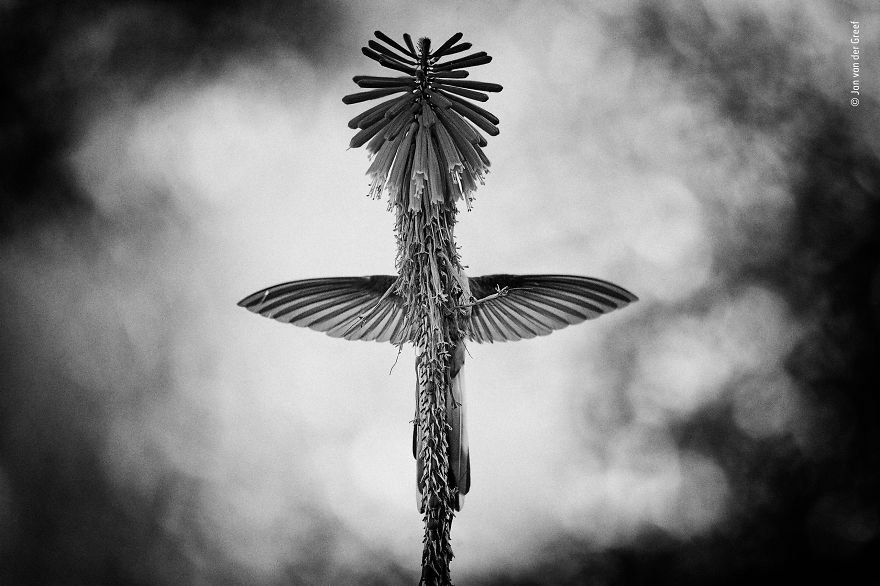
-Via
From the garden of his hotel, Jan noticed that when the hummingbirds rotated around this plant’s spikes, and closed their tails for a moment, a beautiful cross appeared. From the low position of his wheelchair, it took him two half days to get the perfect shot, ‘their fast movements to me symbolise the freedom of our imagination,’ he says. Endemic to Peru, the bearded mountaineer hummingbird spends its day feeding on sweet, nectar-rich plants. Unlike the hummingbird, the showy, dramatic torch lily seen here is not native to the region, but has become a popular food source for these hummingbirds. They are attracted by the delicious nectar of its bright red flowers.
#34 Javier Aznar González De Rueda, Spain, Winner 2018 Wildlife Photographer Portfolio Award
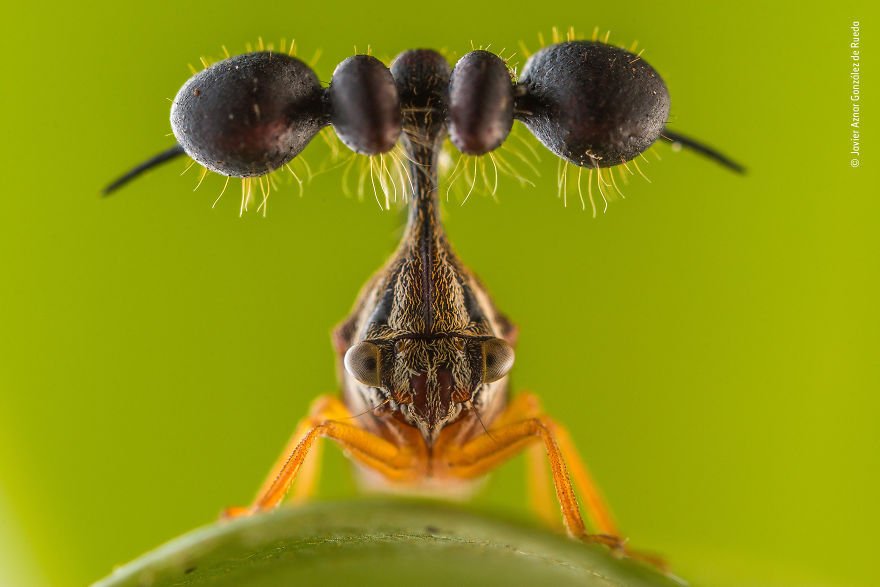
-Via
Little
Big Head
Javier found just two of this species of treehopper in the three months
he spent looking for them. The first flew away before he could
photograph it. Taking great care not to scare this small bug away, he
captured its portrait head-on for maximum impact.
Nearly all treehoppers have enlarged structures known as helmets, which
develop from wing-like forms at the front of the thorax and then fuse
above the body. These often disguise treehoppers as thorns or leaves to
match their host plants. This one is perhaps mimicking an ant to deter
predators, or by simply being difficult to swallow.
#35 "Bear Territory" By Marc Graf, Austria, Highly Commended 2018 Animals In Their Environment
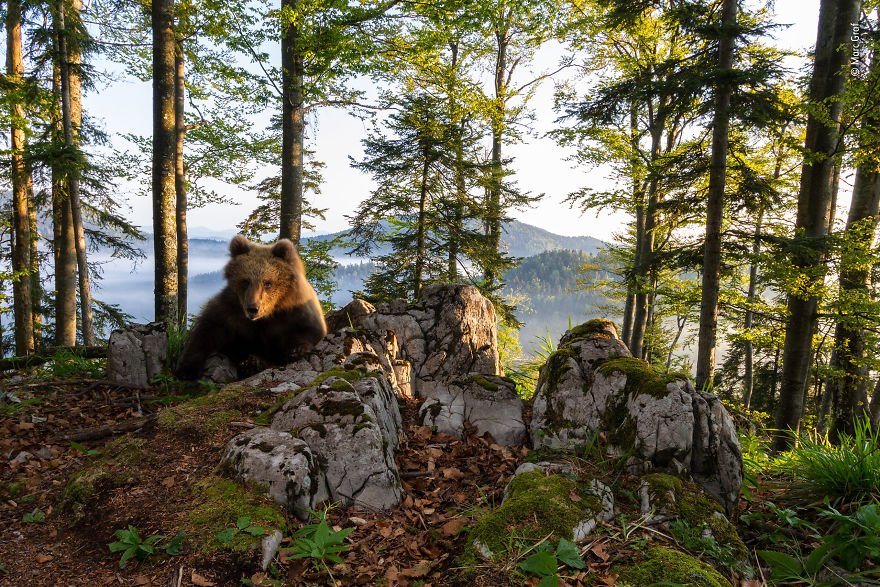
-Via
The brown bears of Notranjska Regional Park are cautious, and so avoided the area where Marc had set up his camera trap, aware something had changed in their environment. However, after 14 long months the box protecting the camera lost all its scent, and the bears finally acclimatised. One morning a young bear strolled up the hill at sunrise ready for its close-up. Brown bears were once found throughout much of Europe, but today their range is greatly diminished and fragmented. While the trend for Slovenia’s brown bear populations shows a steady growth, just a short distance away in Marc’s Austrian homeland there are very few bears left – their biggest threat is conflict with humans.
#36 Ice-Cave Blues By Georg Kantioler, Italy, Highly Commended 2018 Earth’s Environments
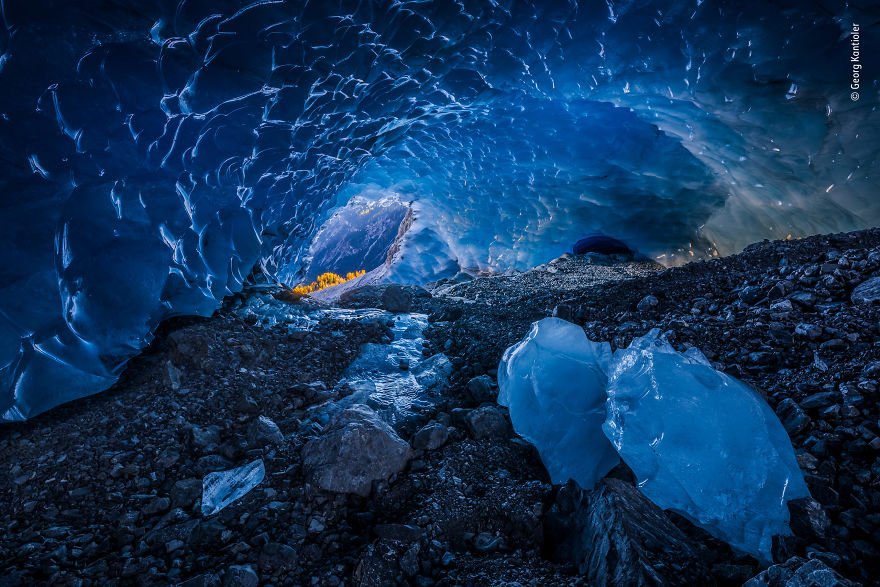
-Via
Last time Georg tried to enter this ice cave, it was deemed too dangerous, due to excessive ice melt. But on this cooler day he made it in. With the sound of dripping water and the creak of the glacier shifting, he used natural light to capture the interior, including the distant larch trees and alpine scenery. ‘A breathtaking yet daunting experience,’ he says. Glacier caves are often carved out by water running through or under a glacier’s ice. Unlike ice caves that are present all year round, glacier caves are seasonal. Global warming has caused some glaciers to completely disappear and others to retreat, meaning caves such as these are becoming less frequent or inaccessible.
#37 Eyes Of The Night By Frans Lanting, The Netherlands, Winner 2018 Wildlife Photographer Of The Year Lifetime Achievement Award
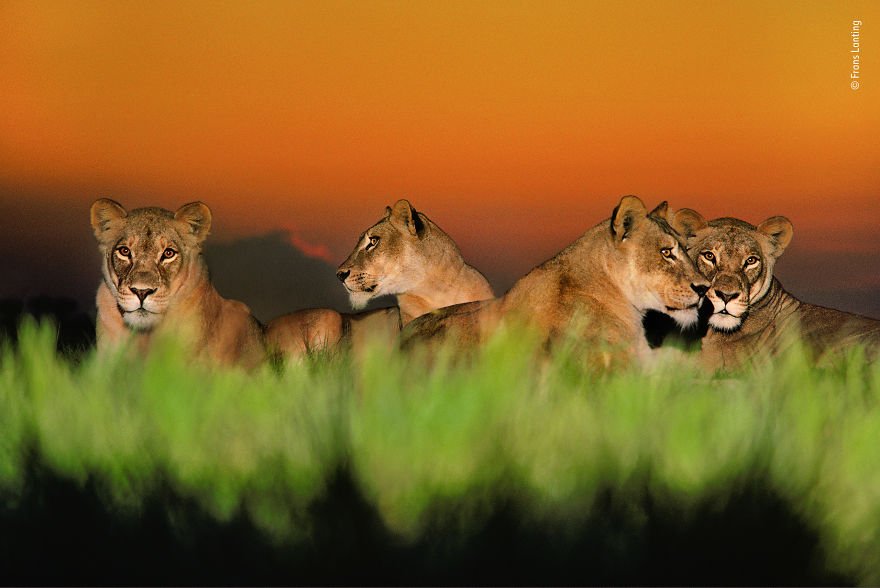
-Via
I like to get eye to eye with the animals I photograph and portray them as individuals. I followed this pride of lionesses for several weeks, and got to know their most intimate moments. Here at dusk, with eyes and ears scanning the bush, they are awake and ready to hunt.
#38 "Looking For Love" By Tony Wu, Usa, Highly Commended 2018 Animal Portraits
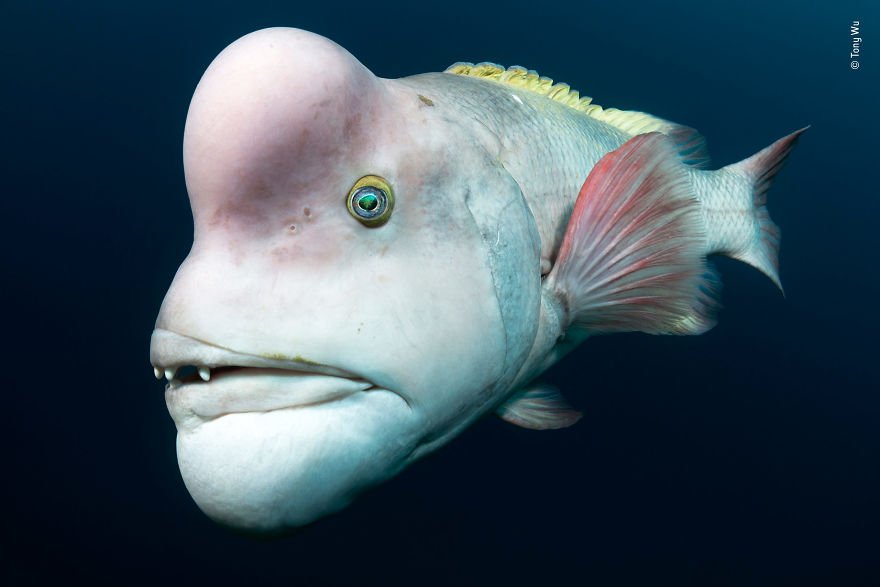
-Via
Tony
was on a mission – he wanted to capture an image that portrayed the
‘unique expression and burning desire of a male in love’. His subject
was the Asian sheepshead wrasse, a fish found near Sado Island. After
years of planning, and amid torrential rain, he finally found an earnest
suitor for his portrait. ‘This,’ he says, ‘is the face of a fish
looking for love’.
If there are no dominant males in the school of Asian sheepshead wrasse,
larger, older female wrasse will change sex. The transformed fish will
use its bulbous head, which turns red in the breeding season, to gain
control over other males, attracting a harem of females in the process.
It will then mate with these females dozens of times a day.
#39 "Glass-House" Guard By Wayne Jones, Australia, Highly Commended 2018 Under Water
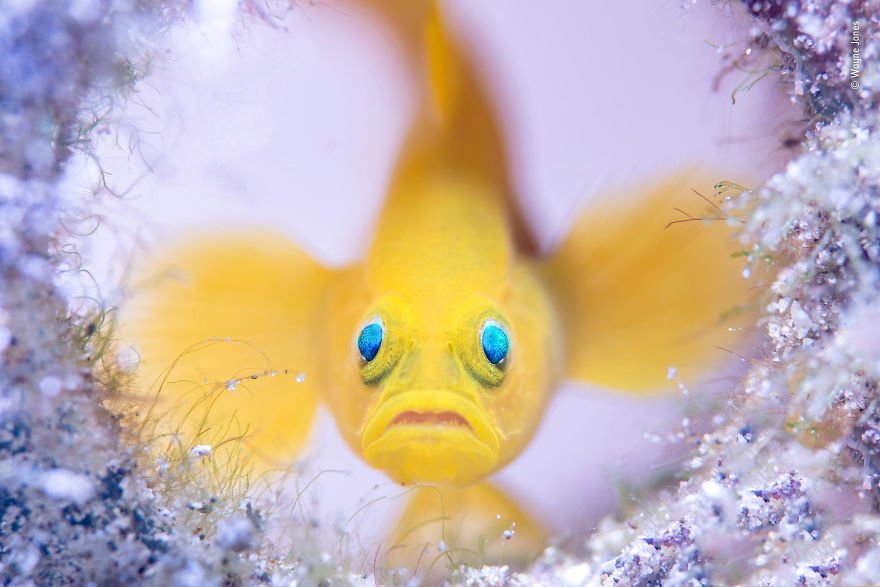
-Via
A yellow pygmy goby floats inside its human-made home: a discarded bottle lying on the seabed. Wayne set up his camera a few centimetres from the bottle’s narrow opening, and focused on the goby’s arresting, bulging blue eyes. The movement of the fish blurred the rest of its features into a haze of yellow. Usually found in breeding pairs, the tiny and colourful yellow pygmy goby often inhabits old worm holes or empty bottles or cans. In this temporary home, the female lays several batches of eggs, while the male takes on guard duty to defend its spawn from intruders. Plastic is an increasing feature of its marine environment.
#40 "Mister Whiskers" By Valter Bernardeschi, Italy, Highly Commended 2018 Animal Portraits

-Via
Extending his camera ahead of him using two monopod poles and a float, Valter slipped into the icy water to photograph the walruses he had spotted from his dinghy. This caught the attention of some curious youngsters who began to swim towards him. Exhilarated by this peaceful encounter, Valter captured this intimate portrait from a pole’s length away. These walruses are likely to live for up to 40 years, spending their days trawling the seafloor, using their whiskers and muzzles to find and extract food. Their thick skin protects them from the cold as they forage mainly for molluscs, such as clams. In the Arctic water, blood flow to the surface of their skin is reduced to retain heat.
#41 "Hellbent" By David Herasimtschuk, Us, Winner 2018 Behaviours Amphibians And Reptiles
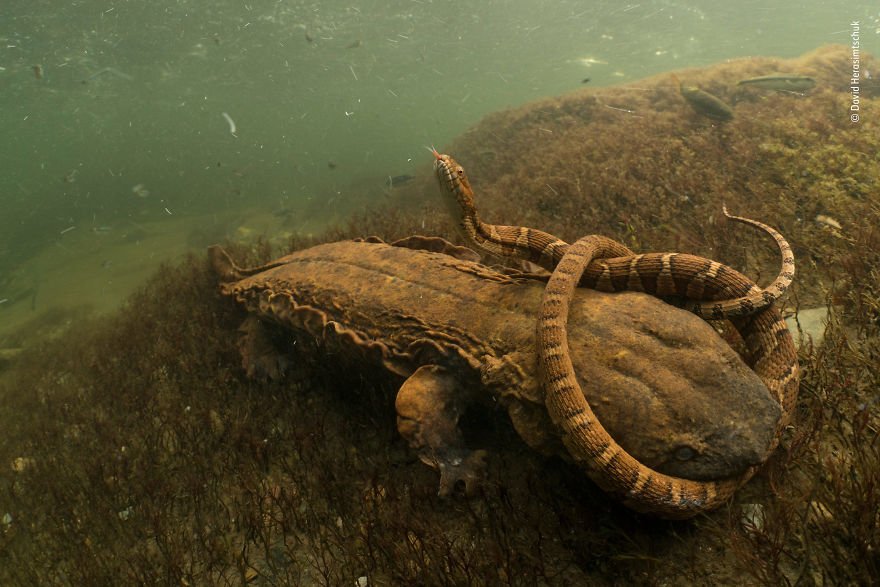
-Via
Clamped in the jaws of a hungry hellbender salamander, things were not looking good for the northern water snake. But when its attacker repositioned its bite, the snake pushed free and escaped. David was thrilled to catch a battle between these two unlikely foes. ‘I’ve seen hellbenders display an array of behaviours, but this was by far the most remarkable,’ he says. Hellbenders are the largest salamanders in the USA and are among the most endangered. Usually they hunt for small prey, such as crayfish, insects and eggs, so a northern water snake is an unexpected choice. These amphibians use suction to secure their prey before using their teeth – a method unlikely to subdue a wriggling snake.
#42 "Late-Night Feed" By Susan Scott, South Africa, Highly Commended 2018 Wildlife Photojournalism
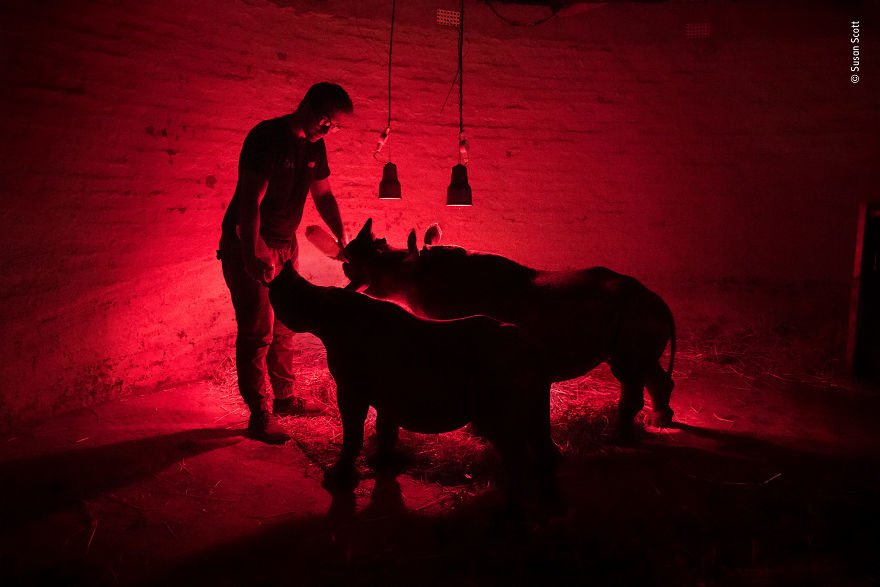
-Via
It
took Susan two years to convince the orphanage to allow her access –
the bond between rhino calves and their carers is fiercely protected.
Moving quietly, she was careful not to disturb these two, Nandi and
Storm, as they were fed by their carer under infrared lamps to minimise
heat loss. For Susan, this image is ‘a peaceful moment amid tremendous
violence’.
Despite conservation efforts, black rhinos remain critically endangered,
as demand for their horn for use in alternative medicine fuels
poaching. Nine months after Susan took her photograph, the orphanage was
attacked, the carers assaulted and two white rhinos killed. Nandi and
Storm were spared – their horns deemed too small to be worth the
trouble.
#43 "The Spring Ball" By David Herasimtschuk, Usa, Highly Commended 2018 Behaviours Amphibians And Reptiles"

-Via
Every spring, hundreds of rough-skinned newts migrate from nearby forests to this pond to breed. David follows suit, spending hours in the icy water. He seized this moment, when one male successfully embraced the female in the centre, while rivals jostled beneath. ‘The males are so desperate to mate,’ says David, ‘that I usually have a few hanging off me’. This large, writhing group of newts indicates a healthy population, where the two lighter skinned ones are female, and the others are male. Scientists have, however, become concerned about a new fungal disease called bsal, which is fatal to newts and other salamanders. Named the amphibian plague, once in a habitat it can decimate numbers.
#44 "Home Of The Quoll" By David Gallan, Australia, Highly Commended 2018 Animals In Their Environment
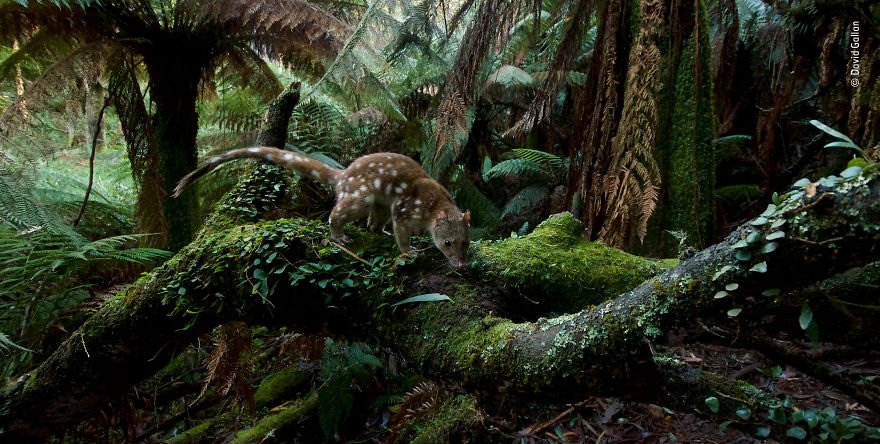
-Via
It took David three years to locate this quoll – and another six months to take this photograph. He set up a camera trap where a fallen log bridged a stream, foregoing flash to minimise disturbance, then placed a scent bait to pause any passing quolls. His perseverance paid off when this hunting female scampered into view. These shy creatures are ferocious predators. Almost a metre long from nose to tail, quolls can slice meat off the reptiles, birds and mammals they hunt with their strong teeth and muscles. Like all quoll species, the spotted-tailed quoll is threatened by habitat loss due to industrial logging and competition with introduced species.
#45 "Fitting The Bill" By Jess Findlay, Canada, Highly Commended 2018 Behaviours Birds
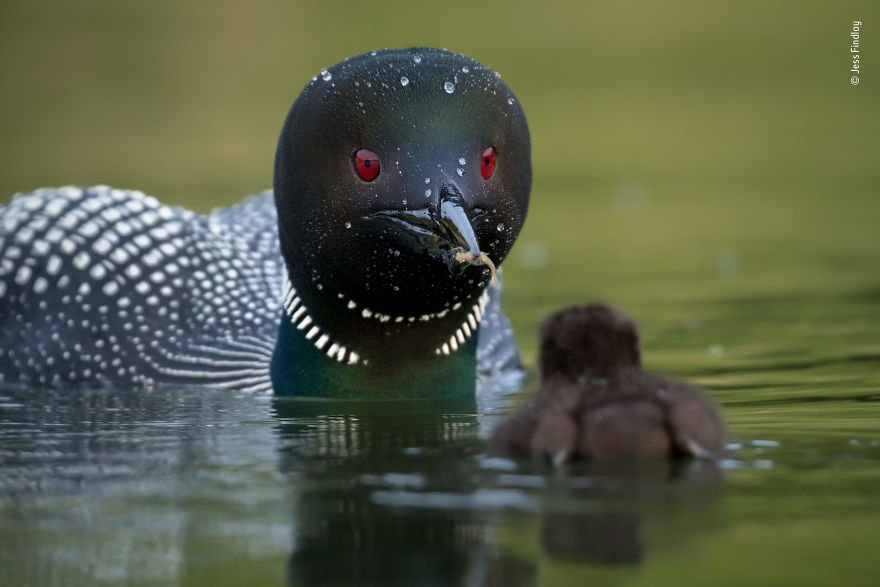
-Via
Jess
captured the intense focus of this great northern diver parent, a
species that usually lays just one to three eggs. With food for its
precious chick gripped in its beak, its piercing red eyes stand out from
its smart summer plumage.
In the first few days of life, young great northern divers struggle to
swallow even small fish. This parent is instead offering its chick a
damselfly nymph. Parents lead them into shallow water, where the young
birds can pluck small aquatic insects from the lake bottom and
underwater vegetation.
#46 "Life Among Litter" By Greg Lecoeur, France, Highly Commended 2018 Wildlife Photojournalism
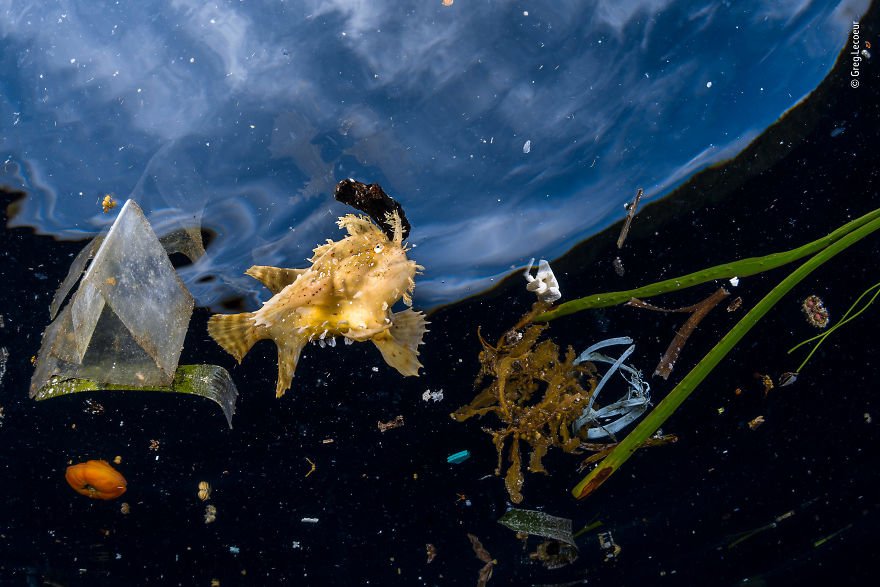
-Via
‘The
ocean is a victim of human activity,’ explains Greg. This frogfish
couldn’t hide among the plastic, and the nearby frond of Sargassum
seaweed was a far cry from the rafts of it that normally shelter this
specialised species. Some people classify the mass of plastic carried on
ocean currents as the seventh continent.
A master of camouflage and a voracious ambush predator, the frogfish
normally stalks its prey through floating islands of brown Sargassum
seaweed, using the lure on its head to entice prey. In recent decades,
it has been forced to share its habitat with some of the 12.7 million
tonnes of plastic that end up in the oceans each year. Reducing our
usage is an obvious solution.
#47 "Blood Thirsty" By Thomas P Peschak, Germany / South Africa, Winner 2018 Behaviours Birds
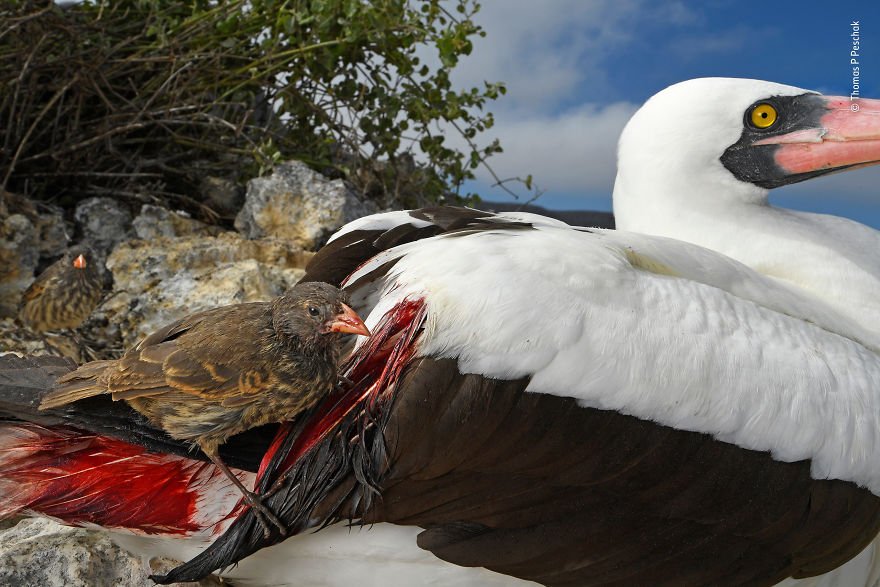
-Via
Working
on a climate change story, Thomas had secured a rare permit to land on
Wolf Island, a remote part of the Galápagos Islands. Scrambling over
loose rocks to reach this plateau, he spied a bizarre scene – pecking
away at the flight feathers of a Nazca booby was a sharp-beaked ground
finch. With scarce food alternatives, it had resorted to drinking blood
to survive.
Encircled by steep cliffs, with no permanent water and little rainfall,
Wolf Island is a difficult place to live. While the boobies can fish in
the ocean, the finches are limited to a scant supply of seeds and
insects. To survive they drink the blood of the Nazca boobies – a
behaviour that may have evolved from feeding on parasites in their
feathers
#48 "Sinuous Moves" By Lorenzo Shoubridge, Italy, Highly Commended 2018 Behaviours Amphibians And Reptiles
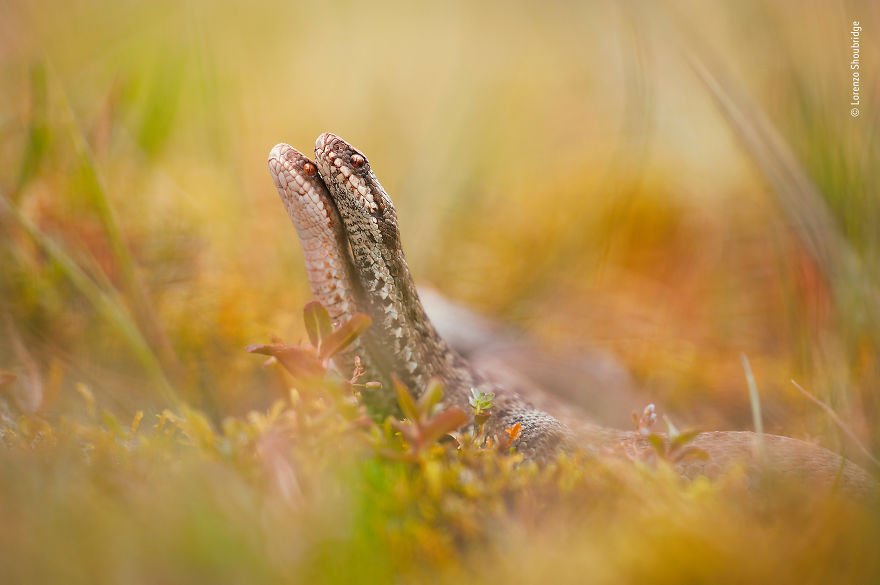
-Via
Lorenzo
watched quietly as the two adders swayed cheek to cheek, aware that
even the smallest movement from him would distract the pair. Glad of the
low angle, he isolated the intertwined bodies of the courting couple,
softly blurring their surroundings in the light of a foreboding sky
These male and female adders are taking part in a courtship ritual.
Bodies entwined, the pair will restlessly rise up and down, constantly
shifting positions and on occasions vibrating their tails. If mating
goes ahead, they will twist closer together, and the female will then
give birth to up to 18 live young about three months later.
#49 "Dinner For Two" By Justin Gilligan, Australia, Highly Commended 2018 Behaviours Invertebrates
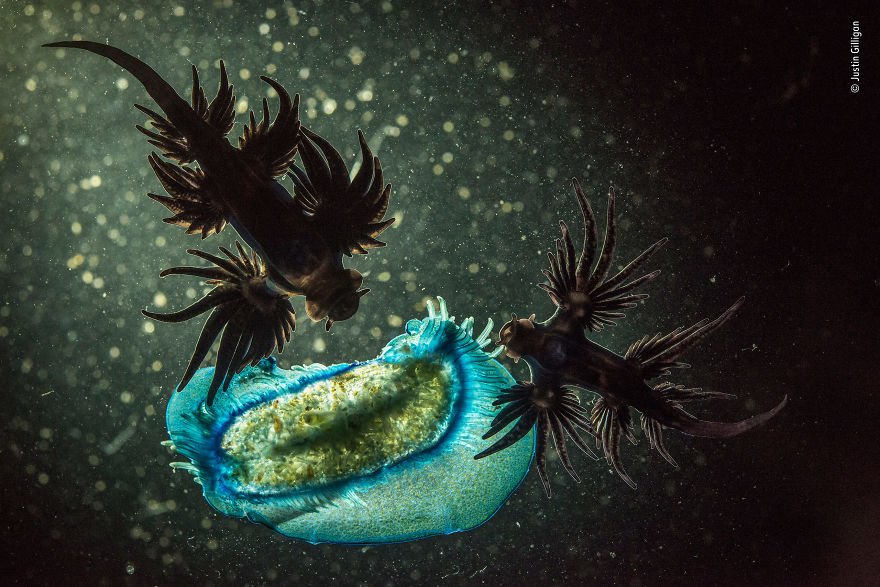
-Via
Justin
spotted these hungry blue dragons closing in on a by-the-wind sailor in
a rock pool, and wanted to capture this ‘different layer of life in the
ocean’. He used an underwater torch to light his shot from beneath, and
framed their elaborate forms from above, against a galaxy of reflective
particles.
Blue dragons are small sea slugs that float upside down buoyed by air
bubbles in their stomachs. They feed on cnidarians, a group of marine
animals that includes jellyfish and this by-the-wind sailor. Storing
stinging cells from their prey in finger-like protrusions, the blue
dragons use this venom to defend themselves against predators.
#50 Inner Fire By Denis Budkov, Russia, Highly Commended 2018 Earth’s Environments
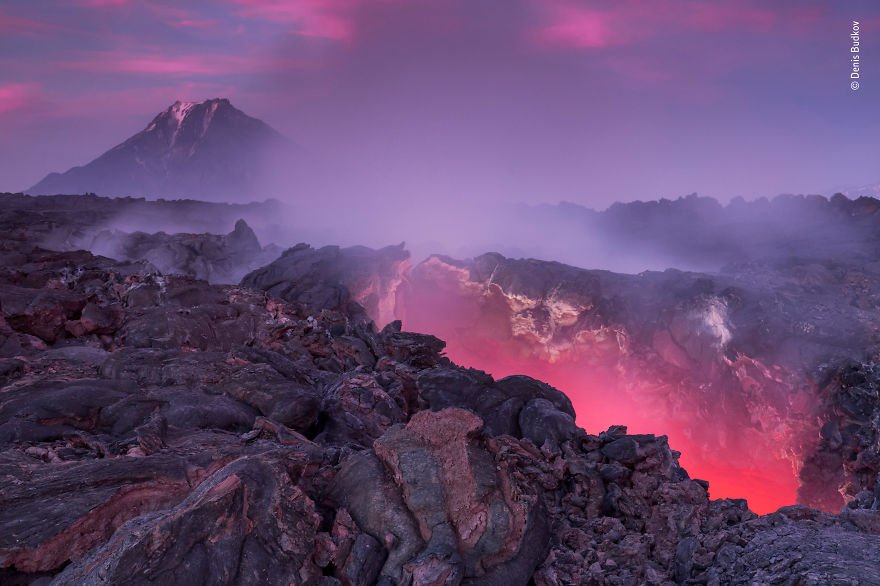
-Via
Plosky Tolbachik volcano stopped erupting in 2013. Yet five years later, molten rock was still glowing as Denis picked his way through the lava field. Suddenly, the heat stopped him in his tracks – getting closer was out of the question. As the Sun set, he framed his shot, the dramatic clouds and glowing fissure in the lava tube reflecting the same deep pink. With around 300 volcanoes, 20 of which are active, the Kamchatka Peninsula is one of the most volcanically active areas in the world. In the north is Plosky Tolbachik, a volcano with a history of eruptions stretching back thousands of years. The most recent episode lasted a year and left a lava plateau 50 metres thick.
#51 Michel D’oultremont, Belgium, Winner 2018 Rising Star Portfolio Award

-Via
Snow Snooze Passionate about not disturbing his subjects, Michel silently approached this slumbering red fox, first walking and then crawling. Finally close enough, he isolated the fox against the snow with a long lens and blurred the background. ‘I stayed with it for a sublime 10 minutes,’ he says. ‘Its ears twitched from time to time, but it never once woke up.’ When hunting, foxes are able to detect their prey through the layers of snow by using their keen sense of smell and excellent hearing. They begin their hunt by standing motionless, listening for any sound of a mouse or vole. When they are sure of their prey’s location, they will leap into the snow, using their strong forelegs to pin their meal to the ground.
#52 "The Ice Pool" By Cristobal Serrano, Spain, Winner 2018 Creative Visions
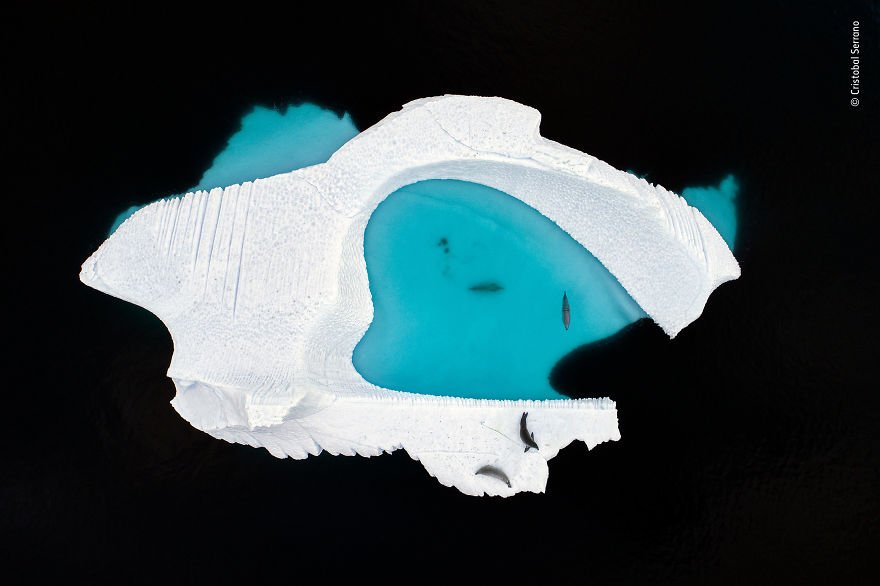
-Via
‘Humans have tried to master the art of sculpture, but icebergs show us we are no match for nature’s great design,’ explains Cristobal. To reveal the beauty of this spectacular ice carving, he used a low-noise drone, flying it high so as not to disturb the crabeater seals. The aerial viewpoint showed a heart-shaped pool in the iceberg’s centre. Crabeater seals feed primarily from dusk to dawn, hauling out onto the ice around the middle of the day to rest. The clear blue area in this image is where the iceberg has melted away below the water line, creating a small and shallow pool, contrasted against the deep and dark ocean.
#53 "The Upside-Down Flamingos" By Paul Mckenzie, Ireland / Hong Kong, Highly Commended 2018 Creative Visions
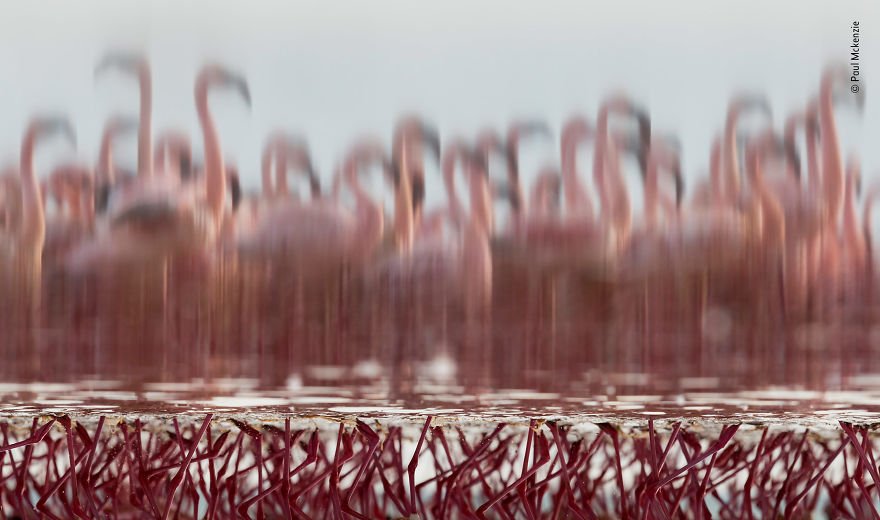
-Via
Lying prone in a quagmire of thick, gooey mud, Paul spent an hour quietly nudging closer to this flock of flamingos. Eventually, he focused on the birds’ red legs, framing the shot to include their reflection. In post-production he rotated the image 180 degrees to create, as he describes, ‘a more abstract reflective image’. Lesser flamingos find safety in numbers and tend to gather in large groups to protect themselves against predators. They feed almost entirely on blue-green algae, but will also feed on crustaceans. Gathering food by holding their beaks upside down in the water, they often synchronise, raising and lowering their heads to feed in orchestrated mass movements.
#54 "Trailblazer" By Christian Wappl, Austria, Highly Commended 2018 Behaviours Invertebrates
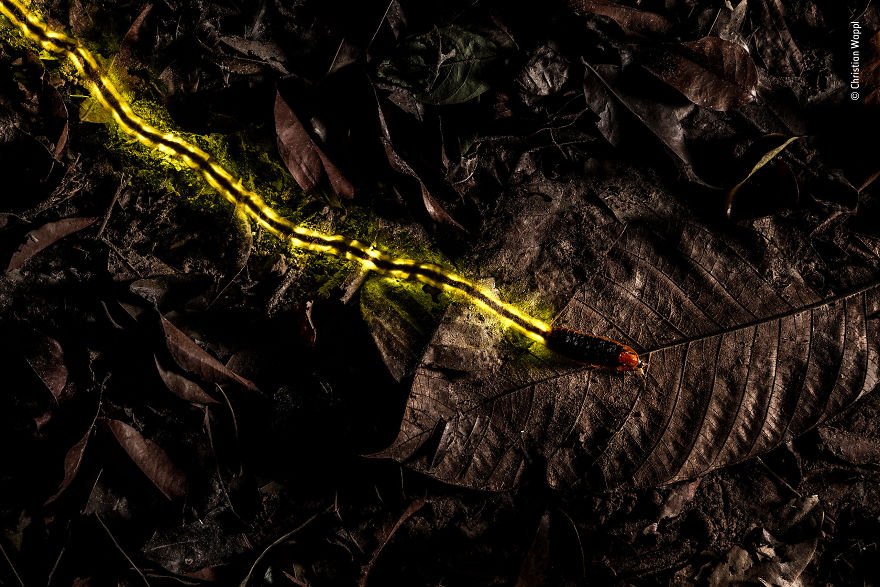
-Via
By one in the morning, the forest was quiet, but its nightlife shone out from the leaf litter. The star of the show was a large firefly larva about seven centimetres long, which emitted a continuous glow from four light organs at its rear end. Using a long exposure with a burst of flash, Christian revealed the larva apparently blazing a trail. Fireflies spend most of their lives as larvae, feeding on other invertebrates such as snails and slugs. This one is a voracious predator of snails, even tackling those many times its size. Its glow is the result of a chemical reaction within its light organs, and is most likely a warning to predators that it is unpalatable.
#55 Delta Design By Paul Mckenzie, Ireland / Hong Kong, Highly Commended 2018 Earth’s Environments
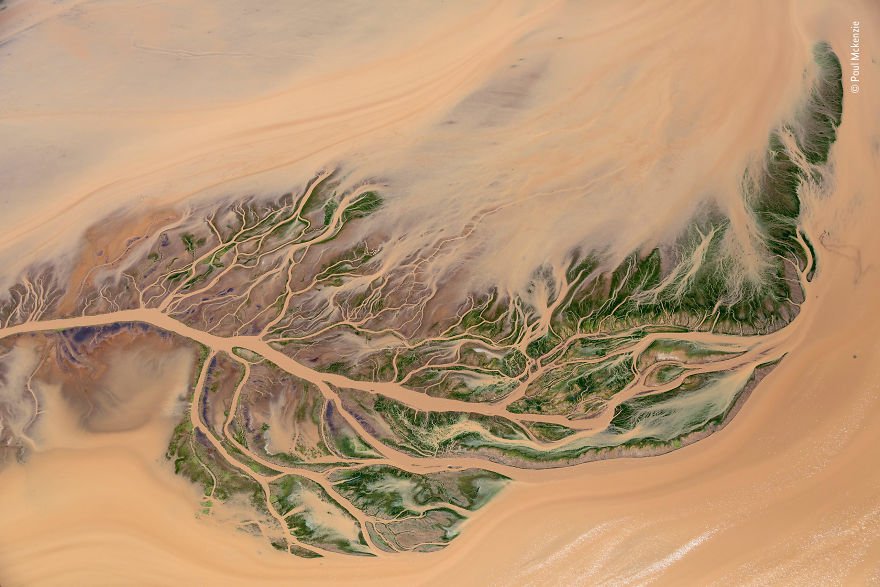
-Via
‘I love images where nature can be depicted as art,’ says Paul. At first glance you might think this is an image of a fern. But it is actually an intricate river delta. As his small plane flew over the scene one final time, Paul framed his shot through the open door, battling against turbulence to capture nature’s silt and water composition. Flowing south through Kenya, the Southern Ewaso Ng’iro River empties into the salt-rich waters of Lake Natron, a major breeding site for hundreds of thousands of lesser flamingos. The birds rely on the river’s fresh water for drinking, as well as for cleaning the hypersaline lake water from their feathers.
#56 Colour, Sound, Action By Liron Gertsman, Canada, Highly Commended 2018 15–17 Years Old
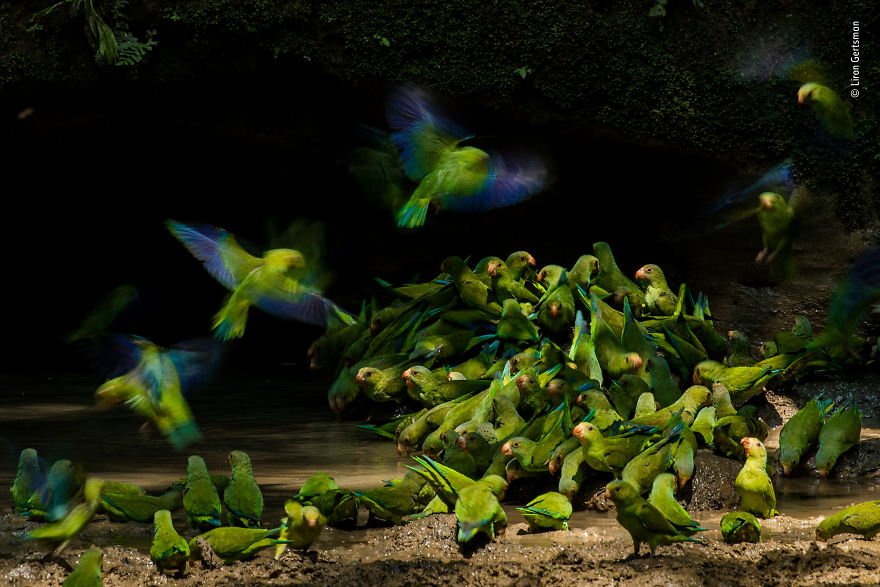
-Via
With
a frenzy of colour and squawks, a flock of cobalt-winged parakeets
descended on the small muddy pool Liron had positioned himself next to.
Using a slow shutter speed, he framed the birds in mid-flight to capture
the flurry of movement. Liron hopes that his image shows ‘just how
amazing and worth protecting nature is’.
The parakeets spend most of their day up in the safety of the trees –
predators are unlikely to catch these strong and rapid flyers up in the
canopy. But the birds need to come down to drink, and so, aware of the
risks, they descend in groups, gathering together near pools. They are
vulnerable to attack on the ground, and so even the slightest noise can
disperse the flock.
#57 Michel D’oultremont, Belgium, Winner 2018 Rising Star Portfolio Award
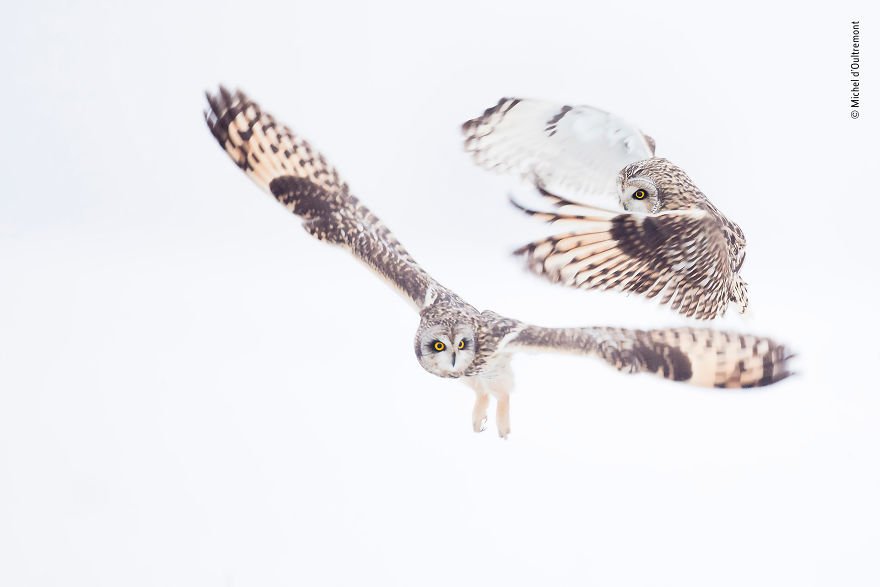
-Via
Silent
Skirmish
In a winter white-out, two short-eared owls squabbled over a mouse that
the larger one had caught. Michel focused on their piercing yellow eyes,
capturing the scene from his car so as not to disturb them. As the owls
demonstrated their aerial agility, Michel captured his shot, but the
contest had no victor. ‘The mouse fell and escaped alive,’ he says.
Skilled hunters, short-eared owls detect their small mammal prey by
listening intently for it rustling in the vegetation of open
countryside. They fly low, almost silently, in their search. Owls are
solo hunters and it is unusual to see two fighting for the same prey –
it may be that the snow meant food was scarce.
#58 Togetherness By Karen Schuenemann, Usa, Highly Commended 2018 Behaviours Birds

-Via
It was late in the season to be nest-building, but the previous nest of this pair of western grebes had been raided by a raccoon, and so they had to start over. Karen spotted this elegant couple on her early morning walk, busily gathering reeds, ‘so absorbed in their work,’ she says, ‘they didn’t seem to notice me’. These two birds are mirroring each other, so their nest-building activity might also be a courtship ritual. Western grebes have intricate display rituals, including the weed dance, where the birds hold tufts of water weeds in their bills and paddle to maintain an upright position, chest to chest.
#59 "Night Flight" By Michael Patrick O’neill, Usa, Winner 2018 Under Water
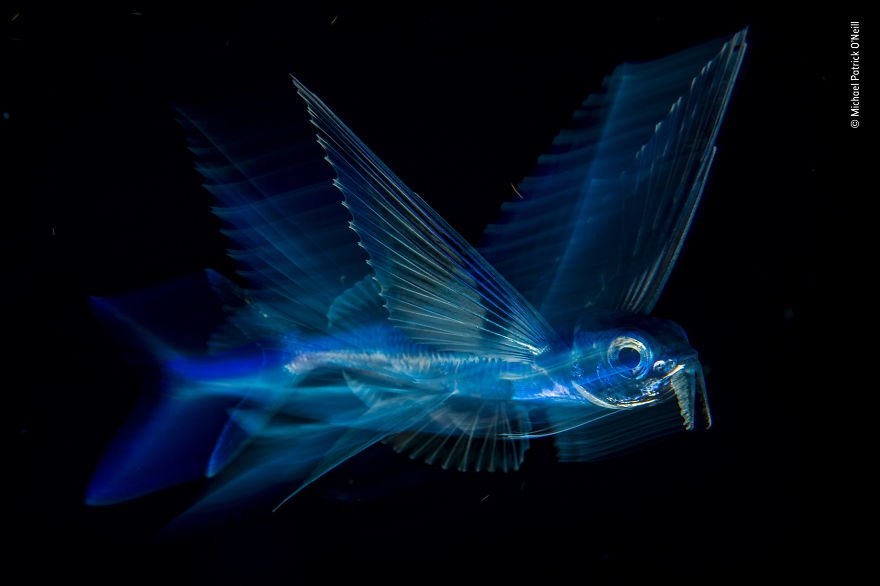
-Via
Late
one night, over deep water, Michael was following a flying fish. By
day, they move extraordinarily fast, but at night they swim slowly just
below the surface. He tried various shutter and flash settings, all the
while keeping track of his small subject. ‘I wanted to create a sense of
movement,’ he says.
By rapidly beating their forked tails, flying fish such as this juvenile
propel themselves in the water until they take off at the surface. By
holding their long, pointed pectoral fins out stiffly, they can glide in
the air for several hundred metres, away from underwater predators.
#60 "Misguided Mayflies" By Jose Manuel Grandío, Spain, Highly Commended 2018 Urban Wildlife
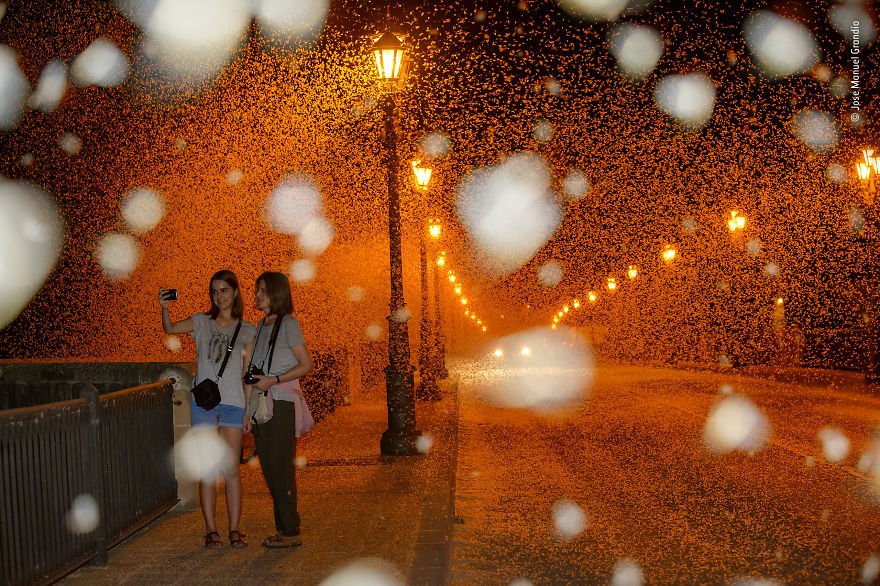
-Via
As
dusk fell over the River Ebro, a thick cloud of mayflies descended on
the bridge. Confused by the dazzling lights, the insects had mistaken it
for water, laying their eggs on the dark asphalt. Jose had only minutes
to document this phenomenon before the air cleared – a carpet of doomed
eggs and wasted bodies left behind.
After emerging from their larval cases, female adult mayflies have just
hours to lay their eggs before they die. The bridge lights have likely
upset their navigation and while the phenomenon may be a spectacle for
tourists, for the mayflies the effect of the artificial light has
devastating consequences.
 When Emily approached, the young sun bear hurried to the front of its filthy zoo cage, seemingly eager to interact with her. Yet when it spotted its keeper, its demeanour changed. As the keeper poked and provoked the bear ‘he started screaming,’ said Emily. ‘I’ve never heard such an awful noise, it was very frightening.’ Sun bears are the world’s rarest bears, yet are commonly exploited for their gall bladders and bile. In traditional Chinese medicine the bile is thought to treat a range of ailments, from hangovers to hepatitis. Cubs are farmed, sometimes living permanently with a catheter used to drain the bile.
When Emily approached, the young sun bear hurried to the front of its filthy zoo cage, seemingly eager to interact with her. Yet when it spotted its keeper, its demeanour changed. As the keeper poked and provoked the bear ‘he started screaming,’ said Emily. ‘I’ve never heard such an awful noise, it was very frightening.’ Sun bears are the world’s rarest bears, yet are commonly exploited for their gall bladders and bile. In traditional Chinese medicine the bile is thought to treat a range of ailments, from hangovers to hepatitis. Cubs are farmed, sometimes living permanently with a catheter used to drain the bile. Timbul, a long-tailed macaque, puts his hand to his face to try and relieve the discomfort of his mask, while being trained to stand upright for a street show. Sights such as this are common in Indonesia, and Joan spent a long time gaining the trust of the monkey’s owners. ‘They are not bad people,’ she says. Most are earning money to send their children to school. Macaques like Timbul live in awful conditions, deprived of the social relationships they need to thrive. They work many hours, dancing and riding bikes, movements that are unnatural and uncomfortable. Animal charities are working to enforce legislation that makes it illegal to take young monkeys from the wild or to trade in them without a permit.
Timbul, a long-tailed macaque, puts his hand to his face to try and relieve the discomfort of his mask, while being trained to stand upright for a street show. Sights such as this are common in Indonesia, and Joan spent a long time gaining the trust of the monkey’s owners. ‘They are not bad people,’ she says. Most are earning money to send their children to school. Macaques like Timbul live in awful conditions, deprived of the social relationships they need to thrive. They work many hours, dancing and riding bikes, movements that are unnatural and uncomfortable. Animal charities are working to enforce legislation that makes it illegal to take young monkeys from the wild or to trade in them without a permit. From the garden of his hotel, Jan noticed that when the hummingbirds rotated around this plant’s spikes, and closed their tails for a moment, a beautiful cross appeared. From the low position of his wheelchair, it took him two half days to get the perfect shot, ‘their fast movements to me symbolise the freedom of our imagination,’ he says. Endemic to Peru, the bearded mountaineer hummingbird spends its day feeding on sweet, nectar-rich plants. Unlike the hummingbird, the showy, dramatic torch lily seen here is not native to the region, but has become a popular food source for these hummingbirds. They are attracted by the delicious nectar of its bright red flowers.
From the garden of his hotel, Jan noticed that when the hummingbirds rotated around this plant’s spikes, and closed their tails for a moment, a beautiful cross appeared. From the low position of his wheelchair, it took him two half days to get the perfect shot, ‘their fast movements to me symbolise the freedom of our imagination,’ he says. Endemic to Peru, the bearded mountaineer hummingbird spends its day feeding on sweet, nectar-rich plants. Unlike the hummingbird, the showy, dramatic torch lily seen here is not native to the region, but has become a popular food source for these hummingbirds. They are attracted by the delicious nectar of its bright red flowers. Little
Big Head
Javier found just two of this species of treehopper in the three months
he spent looking for them. The first flew away before he could
photograph it. Taking great care not to scare this small bug away, he
captured its portrait head-on for maximum impact.
Nearly all treehoppers have enlarged structures known as helmets, which
develop from wing-like forms at the front of the thorax and then fuse
above the body. These often disguise treehoppers as thorns or leaves to
match their host plants. This one is perhaps mimicking an ant to deter
predators, or by simply being difficult to swallow.
Little
Big Head
Javier found just two of this species of treehopper in the three months
he spent looking for them. The first flew away before he could
photograph it. Taking great care not to scare this small bug away, he
captured its portrait head-on for maximum impact.
Nearly all treehoppers have enlarged structures known as helmets, which
develop from wing-like forms at the front of the thorax and then fuse
above the body. These often disguise treehoppers as thorns or leaves to
match their host plants. This one is perhaps mimicking an ant to deter
predators, or by simply being difficult to swallow. The brown bears of Notranjska Regional Park are cautious, and so avoided the area where Marc had set up his camera trap, aware something had changed in their environment. However, after 14 long months the box protecting the camera lost all its scent, and the bears finally acclimatised. One morning a young bear strolled up the hill at sunrise ready for its close-up. Brown bears were once found throughout much of Europe, but today their range is greatly diminished and fragmented. While the trend for Slovenia’s brown bear populations shows a steady growth, just a short distance away in Marc’s Austrian homeland there are very few bears left – their biggest threat is conflict with humans.
The brown bears of Notranjska Regional Park are cautious, and so avoided the area where Marc had set up his camera trap, aware something had changed in their environment. However, after 14 long months the box protecting the camera lost all its scent, and the bears finally acclimatised. One morning a young bear strolled up the hill at sunrise ready for its close-up. Brown bears were once found throughout much of Europe, but today their range is greatly diminished and fragmented. While the trend for Slovenia’s brown bear populations shows a steady growth, just a short distance away in Marc’s Austrian homeland there are very few bears left – their biggest threat is conflict with humans. Last time Georg tried to enter this ice cave, it was deemed too dangerous, due to excessive ice melt. But on this cooler day he made it in. With the sound of dripping water and the creak of the glacier shifting, he used natural light to capture the interior, including the distant larch trees and alpine scenery. ‘A breathtaking yet daunting experience,’ he says. Glacier caves are often carved out by water running through or under a glacier’s ice. Unlike ice caves that are present all year round, glacier caves are seasonal. Global warming has caused some glaciers to completely disappear and others to retreat, meaning caves such as these are becoming less frequent or inaccessible.
Last time Georg tried to enter this ice cave, it was deemed too dangerous, due to excessive ice melt. But on this cooler day he made it in. With the sound of dripping water and the creak of the glacier shifting, he used natural light to capture the interior, including the distant larch trees and alpine scenery. ‘A breathtaking yet daunting experience,’ he says. Glacier caves are often carved out by water running through or under a glacier’s ice. Unlike ice caves that are present all year round, glacier caves are seasonal. Global warming has caused some glaciers to completely disappear and others to retreat, meaning caves such as these are becoming less frequent or inaccessible. I like to get eye to eye with the animals I photograph and portray them as individuals. I followed this pride of lionesses for several weeks, and got to know their most intimate moments. Here at dusk, with eyes and ears scanning the bush, they are awake and ready to hunt.
I like to get eye to eye with the animals I photograph and portray them as individuals. I followed this pride of lionesses for several weeks, and got to know their most intimate moments. Here at dusk, with eyes and ears scanning the bush, they are awake and ready to hunt. Tony
was on a mission – he wanted to capture an image that portrayed the
‘unique expression and burning desire of a male in love’. His subject
was the Asian sheepshead wrasse, a fish found near Sado Island. After
years of planning, and amid torrential rain, he finally found an earnest
suitor for his portrait. ‘This,’ he says, ‘is the face of a fish
looking for love’.
If there are no dominant males in the school of Asian sheepshead wrasse,
larger, older female wrasse will change sex. The transformed fish will
use its bulbous head, which turns red in the breeding season, to gain
control over other males, attracting a harem of females in the process.
It will then mate with these females dozens of times a day.
Tony
was on a mission – he wanted to capture an image that portrayed the
‘unique expression and burning desire of a male in love’. His subject
was the Asian sheepshead wrasse, a fish found near Sado Island. After
years of planning, and amid torrential rain, he finally found an earnest
suitor for his portrait. ‘This,’ he says, ‘is the face of a fish
looking for love’.
If there are no dominant males in the school of Asian sheepshead wrasse,
larger, older female wrasse will change sex. The transformed fish will
use its bulbous head, which turns red in the breeding season, to gain
control over other males, attracting a harem of females in the process.
It will then mate with these females dozens of times a day. A yellow pygmy goby floats inside its human-made home: a discarded bottle lying on the seabed. Wayne set up his camera a few centimetres from the bottle’s narrow opening, and focused on the goby’s arresting, bulging blue eyes. The movement of the fish blurred the rest of its features into a haze of yellow. Usually found in breeding pairs, the tiny and colourful yellow pygmy goby often inhabits old worm holes or empty bottles or cans. In this temporary home, the female lays several batches of eggs, while the male takes on guard duty to defend its spawn from intruders. Plastic is an increasing feature of its marine environment.
A yellow pygmy goby floats inside its human-made home: a discarded bottle lying on the seabed. Wayne set up his camera a few centimetres from the bottle’s narrow opening, and focused on the goby’s arresting, bulging blue eyes. The movement of the fish blurred the rest of its features into a haze of yellow. Usually found in breeding pairs, the tiny and colourful yellow pygmy goby often inhabits old worm holes or empty bottles or cans. In this temporary home, the female lays several batches of eggs, while the male takes on guard duty to defend its spawn from intruders. Plastic is an increasing feature of its marine environment. Extending his camera ahead of him using two monopod poles and a float, Valter slipped into the icy water to photograph the walruses he had spotted from his dinghy. This caught the attention of some curious youngsters who began to swim towards him. Exhilarated by this peaceful encounter, Valter captured this intimate portrait from a pole’s length away. These walruses are likely to live for up to 40 years, spending their days trawling the seafloor, using their whiskers and muzzles to find and extract food. Their thick skin protects them from the cold as they forage mainly for molluscs, such as clams. In the Arctic water, blood flow to the surface of their skin is reduced to retain heat.
Extending his camera ahead of him using two monopod poles and a float, Valter slipped into the icy water to photograph the walruses he had spotted from his dinghy. This caught the attention of some curious youngsters who began to swim towards him. Exhilarated by this peaceful encounter, Valter captured this intimate portrait from a pole’s length away. These walruses are likely to live for up to 40 years, spending their days trawling the seafloor, using their whiskers and muzzles to find and extract food. Their thick skin protects them from the cold as they forage mainly for molluscs, such as clams. In the Arctic water, blood flow to the surface of their skin is reduced to retain heat. Clamped in the jaws of a hungry hellbender salamander, things were not looking good for the northern water snake. But when its attacker repositioned its bite, the snake pushed free and escaped. David was thrilled to catch a battle between these two unlikely foes. ‘I’ve seen hellbenders display an array of behaviours, but this was by far the most remarkable,’ he says. Hellbenders are the largest salamanders in the USA and are among the most endangered. Usually they hunt for small prey, such as crayfish, insects and eggs, so a northern water snake is an unexpected choice. These amphibians use suction to secure their prey before using their teeth – a method unlikely to subdue a wriggling snake.
Clamped in the jaws of a hungry hellbender salamander, things were not looking good for the northern water snake. But when its attacker repositioned its bite, the snake pushed free and escaped. David was thrilled to catch a battle between these two unlikely foes. ‘I’ve seen hellbenders display an array of behaviours, but this was by far the most remarkable,’ he says. Hellbenders are the largest salamanders in the USA and are among the most endangered. Usually they hunt for small prey, such as crayfish, insects and eggs, so a northern water snake is an unexpected choice. These amphibians use suction to secure their prey before using their teeth – a method unlikely to subdue a wriggling snake.
 It
took Susan two years to convince the orphanage to allow her access –
the bond between rhino calves and their carers is fiercely protected.
Moving quietly, she was careful not to disturb these two, Nandi and
Storm, as they were fed by their carer under infrared lamps to minimise
heat loss. For Susan, this image is ‘a peaceful moment amid tremendous
violence’.
Despite conservation efforts, black rhinos remain critically endangered,
as demand for their horn for use in alternative medicine fuels
poaching. Nine months after Susan took her photograph, the orphanage was
attacked, the carers assaulted and two white rhinos killed. Nandi and
Storm were spared – their horns deemed too small to be worth the
trouble.
It
took Susan two years to convince the orphanage to allow her access –
the bond between rhino calves and their carers is fiercely protected.
Moving quietly, she was careful not to disturb these two, Nandi and
Storm, as they were fed by their carer under infrared lamps to minimise
heat loss. For Susan, this image is ‘a peaceful moment amid tremendous
violence’.
Despite conservation efforts, black rhinos remain critically endangered,
as demand for their horn for use in alternative medicine fuels
poaching. Nine months after Susan took her photograph, the orphanage was
attacked, the carers assaulted and two white rhinos killed. Nandi and
Storm were spared – their horns deemed too small to be worth the
trouble. Every spring, hundreds of rough-skinned newts migrate from nearby forests to this pond to breed. David follows suit, spending hours in the icy water. He seized this moment, when one male successfully embraced the female in the centre, while rivals jostled beneath. ‘The males are so desperate to mate,’ says David, ‘that I usually have a few hanging off me’. This large, writhing group of newts indicates a healthy population, where the two lighter skinned ones are female, and the others are male. Scientists have, however, become concerned about a new fungal disease called bsal, which is fatal to newts and other salamanders. Named the amphibian plague, once in a habitat it can decimate numbers.
Every spring, hundreds of rough-skinned newts migrate from nearby forests to this pond to breed. David follows suit, spending hours in the icy water. He seized this moment, when one male successfully embraced the female in the centre, while rivals jostled beneath. ‘The males are so desperate to mate,’ says David, ‘that I usually have a few hanging off me’. This large, writhing group of newts indicates a healthy population, where the two lighter skinned ones are female, and the others are male. Scientists have, however, become concerned about a new fungal disease called bsal, which is fatal to newts and other salamanders. Named the amphibian plague, once in a habitat it can decimate numbers. It took David three years to locate this quoll – and another six months to take this photograph. He set up a camera trap where a fallen log bridged a stream, foregoing flash to minimise disturbance, then placed a scent bait to pause any passing quolls. His perseverance paid off when this hunting female scampered into view. These shy creatures are ferocious predators. Almost a metre long from nose to tail, quolls can slice meat off the reptiles, birds and mammals they hunt with their strong teeth and muscles. Like all quoll species, the spotted-tailed quoll is threatened by habitat loss due to industrial logging and competition with introduced species.
It took David three years to locate this quoll – and another six months to take this photograph. He set up a camera trap where a fallen log bridged a stream, foregoing flash to minimise disturbance, then placed a scent bait to pause any passing quolls. His perseverance paid off when this hunting female scampered into view. These shy creatures are ferocious predators. Almost a metre long from nose to tail, quolls can slice meat off the reptiles, birds and mammals they hunt with their strong teeth and muscles. Like all quoll species, the spotted-tailed quoll is threatened by habitat loss due to industrial logging and competition with introduced species. Jess
captured the intense focus of this great northern diver parent, a
species that usually lays just one to three eggs. With food for its
precious chick gripped in its beak, its piercing red eyes stand out from
its smart summer plumage.
In the first few days of life, young great northern divers struggle to
swallow even small fish. This parent is instead offering its chick a
damselfly nymph. Parents lead them into shallow water, where the young
birds can pluck small aquatic insects from the lake bottom and
underwater vegetation.
Jess
captured the intense focus of this great northern diver parent, a
species that usually lays just one to three eggs. With food for its
precious chick gripped in its beak, its piercing red eyes stand out from
its smart summer plumage.
In the first few days of life, young great northern divers struggle to
swallow even small fish. This parent is instead offering its chick a
damselfly nymph. Parents lead them into shallow water, where the young
birds can pluck small aquatic insects from the lake bottom and
underwater vegetation. ‘The
ocean is a victim of human activity,’ explains Greg. This frogfish
couldn’t hide among the plastic, and the nearby frond of Sargassum
seaweed was a far cry from the rafts of it that normally shelter this
specialised species. Some people classify the mass of plastic carried on
ocean currents as the seventh continent.
A master of camouflage and a voracious ambush predator, the frogfish
normally stalks its prey through floating islands of brown Sargassum
seaweed, using the lure on its head to entice prey. In recent decades,
it has been forced to share its habitat with some of the 12.7 million
tonnes of plastic that end up in the oceans each year. Reducing our
usage is an obvious solution.
‘The
ocean is a victim of human activity,’ explains Greg. This frogfish
couldn’t hide among the plastic, and the nearby frond of Sargassum
seaweed was a far cry from the rafts of it that normally shelter this
specialised species. Some people classify the mass of plastic carried on
ocean currents as the seventh continent.
A master of camouflage and a voracious ambush predator, the frogfish
normally stalks its prey through floating islands of brown Sargassum
seaweed, using the lure on its head to entice prey. In recent decades,
it has been forced to share its habitat with some of the 12.7 million
tonnes of plastic that end up in the oceans each year. Reducing our
usage is an obvious solution. Working
on a climate change story, Thomas had secured a rare permit to land on
Wolf Island, a remote part of the Galápagos Islands. Scrambling over
loose rocks to reach this plateau, he spied a bizarre scene – pecking
away at the flight feathers of a Nazca booby was a sharp-beaked ground
finch. With scarce food alternatives, it had resorted to drinking blood
to survive.
Encircled by steep cliffs, with no permanent water and little rainfall,
Wolf Island is a difficult place to live. While the boobies can fish in
the ocean, the finches are limited to a scant supply of seeds and
insects. To survive they drink the blood of the Nazca boobies – a
behaviour that may have evolved from feeding on parasites in their
feathers
Working
on a climate change story, Thomas had secured a rare permit to land on
Wolf Island, a remote part of the Galápagos Islands. Scrambling over
loose rocks to reach this plateau, he spied a bizarre scene – pecking
away at the flight feathers of a Nazca booby was a sharp-beaked ground
finch. With scarce food alternatives, it had resorted to drinking blood
to survive.
Encircled by steep cliffs, with no permanent water and little rainfall,
Wolf Island is a difficult place to live. While the boobies can fish in
the ocean, the finches are limited to a scant supply of seeds and
insects. To survive they drink the blood of the Nazca boobies – a
behaviour that may have evolved from feeding on parasites in their
feathers Lorenzo
watched quietly as the two adders swayed cheek to cheek, aware that
even the smallest movement from him would distract the pair. Glad of the
low angle, he isolated the intertwined bodies of the courting couple,
softly blurring their surroundings in the light of a foreboding sky
These male and female adders are taking part in a courtship ritual.
Bodies entwined, the pair will restlessly rise up and down, constantly
shifting positions and on occasions vibrating their tails. If mating
goes ahead, they will twist closer together, and the female will then
give birth to up to 18 live young about three months later.
Lorenzo
watched quietly as the two adders swayed cheek to cheek, aware that
even the smallest movement from him would distract the pair. Glad of the
low angle, he isolated the intertwined bodies of the courting couple,
softly blurring their surroundings in the light of a foreboding sky
These male and female adders are taking part in a courtship ritual.
Bodies entwined, the pair will restlessly rise up and down, constantly
shifting positions and on occasions vibrating their tails. If mating
goes ahead, they will twist closer together, and the female will then
give birth to up to 18 live young about three months later. Justin
spotted these hungry blue dragons closing in on a by-the-wind sailor in
a rock pool, and wanted to capture this ‘different layer of life in the
ocean’. He used an underwater torch to light his shot from beneath, and
framed their elaborate forms from above, against a galaxy of reflective
particles.
Blue dragons are small sea slugs that float upside down buoyed by air
bubbles in their stomachs. They feed on cnidarians, a group of marine
animals that includes jellyfish and this by-the-wind sailor. Storing
stinging cells from their prey in finger-like protrusions, the blue
dragons use this venom to defend themselves against predators.
Justin
spotted these hungry blue dragons closing in on a by-the-wind sailor in
a rock pool, and wanted to capture this ‘different layer of life in the
ocean’. He used an underwater torch to light his shot from beneath, and
framed their elaborate forms from above, against a galaxy of reflective
particles.
Blue dragons are small sea slugs that float upside down buoyed by air
bubbles in their stomachs. They feed on cnidarians, a group of marine
animals that includes jellyfish and this by-the-wind sailor. Storing
stinging cells from their prey in finger-like protrusions, the blue
dragons use this venom to defend themselves against predators. Plosky Tolbachik volcano stopped erupting in 2013. Yet five years later, molten rock was still glowing as Denis picked his way through the lava field. Suddenly, the heat stopped him in his tracks – getting closer was out of the question. As the Sun set, he framed his shot, the dramatic clouds and glowing fissure in the lava tube reflecting the same deep pink. With around 300 volcanoes, 20 of which are active, the Kamchatka Peninsula is one of the most volcanically active areas in the world. In the north is Plosky Tolbachik, a volcano with a history of eruptions stretching back thousands of years. The most recent episode lasted a year and left a lava plateau 50 metres thick.
Plosky Tolbachik volcano stopped erupting in 2013. Yet five years later, molten rock was still glowing as Denis picked his way through the lava field. Suddenly, the heat stopped him in his tracks – getting closer was out of the question. As the Sun set, he framed his shot, the dramatic clouds and glowing fissure in the lava tube reflecting the same deep pink. With around 300 volcanoes, 20 of which are active, the Kamchatka Peninsula is one of the most volcanically active areas in the world. In the north is Plosky Tolbachik, a volcano with a history of eruptions stretching back thousands of years. The most recent episode lasted a year and left a lava plateau 50 metres thick. Snow Snooze Passionate about not disturbing his subjects, Michel silently approached this slumbering red fox, first walking and then crawling. Finally close enough, he isolated the fox against the snow with a long lens and blurred the background. ‘I stayed with it for a sublime 10 minutes,’ he says. ‘Its ears twitched from time to time, but it never once woke up.’ When hunting, foxes are able to detect their prey through the layers of snow by using their keen sense of smell and excellent hearing. They begin their hunt by standing motionless, listening for any sound of a mouse or vole. When they are sure of their prey’s location, they will leap into the snow, using their strong forelegs to pin their meal to the ground.
Snow Snooze Passionate about not disturbing his subjects, Michel silently approached this slumbering red fox, first walking and then crawling. Finally close enough, he isolated the fox against the snow with a long lens and blurred the background. ‘I stayed with it for a sublime 10 minutes,’ he says. ‘Its ears twitched from time to time, but it never once woke up.’ When hunting, foxes are able to detect their prey through the layers of snow by using their keen sense of smell and excellent hearing. They begin their hunt by standing motionless, listening for any sound of a mouse or vole. When they are sure of their prey’s location, they will leap into the snow, using their strong forelegs to pin their meal to the ground. ‘Humans have tried to master the art of sculpture, but icebergs show us we are no match for nature’s great design,’ explains Cristobal. To reveal the beauty of this spectacular ice carving, he used a low-noise drone, flying it high so as not to disturb the crabeater seals. The aerial viewpoint showed a heart-shaped pool in the iceberg’s centre. Crabeater seals feed primarily from dusk to dawn, hauling out onto the ice around the middle of the day to rest. The clear blue area in this image is where the iceberg has melted away below the water line, creating a small and shallow pool, contrasted against the deep and dark ocean.
‘Humans have tried to master the art of sculpture, but icebergs show us we are no match for nature’s great design,’ explains Cristobal. To reveal the beauty of this spectacular ice carving, he used a low-noise drone, flying it high so as not to disturb the crabeater seals. The aerial viewpoint showed a heart-shaped pool in the iceberg’s centre. Crabeater seals feed primarily from dusk to dawn, hauling out onto the ice around the middle of the day to rest. The clear blue area in this image is where the iceberg has melted away below the water line, creating a small and shallow pool, contrasted against the deep and dark ocean. Lying prone in a quagmire of thick, gooey mud, Paul spent an hour quietly nudging closer to this flock of flamingos. Eventually, he focused on the birds’ red legs, framing the shot to include their reflection. In post-production he rotated the image 180 degrees to create, as he describes, ‘a more abstract reflective image’. Lesser flamingos find safety in numbers and tend to gather in large groups to protect themselves against predators. They feed almost entirely on blue-green algae, but will also feed on crustaceans. Gathering food by holding their beaks upside down in the water, they often synchronise, raising and lowering their heads to feed in orchestrated mass movements.
Lying prone in a quagmire of thick, gooey mud, Paul spent an hour quietly nudging closer to this flock of flamingos. Eventually, he focused on the birds’ red legs, framing the shot to include their reflection. In post-production he rotated the image 180 degrees to create, as he describes, ‘a more abstract reflective image’. Lesser flamingos find safety in numbers and tend to gather in large groups to protect themselves against predators. They feed almost entirely on blue-green algae, but will also feed on crustaceans. Gathering food by holding their beaks upside down in the water, they often synchronise, raising and lowering their heads to feed in orchestrated mass movements. By one in the morning, the forest was quiet, but its nightlife shone out from the leaf litter. The star of the show was a large firefly larva about seven centimetres long, which emitted a continuous glow from four light organs at its rear end. Using a long exposure with a burst of flash, Christian revealed the larva apparently blazing a trail. Fireflies spend most of their lives as larvae, feeding on other invertebrates such as snails and slugs. This one is a voracious predator of snails, even tackling those many times its size. Its glow is the result of a chemical reaction within its light organs, and is most likely a warning to predators that it is unpalatable.
By one in the morning, the forest was quiet, but its nightlife shone out from the leaf litter. The star of the show was a large firefly larva about seven centimetres long, which emitted a continuous glow from four light organs at its rear end. Using a long exposure with a burst of flash, Christian revealed the larva apparently blazing a trail. Fireflies spend most of their lives as larvae, feeding on other invertebrates such as snails and slugs. This one is a voracious predator of snails, even tackling those many times its size. Its glow is the result of a chemical reaction within its light organs, and is most likely a warning to predators that it is unpalatable. ‘I love images where nature can be depicted as art,’ says Paul. At first glance you might think this is an image of a fern. But it is actually an intricate river delta. As his small plane flew over the scene one final time, Paul framed his shot through the open door, battling against turbulence to capture nature’s silt and water composition. Flowing south through Kenya, the Southern Ewaso Ng’iro River empties into the salt-rich waters of Lake Natron, a major breeding site for hundreds of thousands of lesser flamingos. The birds rely on the river’s fresh water for drinking, as well as for cleaning the hypersaline lake water from their feathers.
‘I love images where nature can be depicted as art,’ says Paul. At first glance you might think this is an image of a fern. But it is actually an intricate river delta. As his small plane flew over the scene one final time, Paul framed his shot through the open door, battling against turbulence to capture nature’s silt and water composition. Flowing south through Kenya, the Southern Ewaso Ng’iro River empties into the salt-rich waters of Lake Natron, a major breeding site for hundreds of thousands of lesser flamingos. The birds rely on the river’s fresh water for drinking, as well as for cleaning the hypersaline lake water from their feathers. With
a frenzy of colour and squawks, a flock of cobalt-winged parakeets
descended on the small muddy pool Liron had positioned himself next to.
Using a slow shutter speed, he framed the birds in mid-flight to capture
the flurry of movement. Liron hopes that his image shows ‘just how
amazing and worth protecting nature is’.
The parakeets spend most of their day up in the safety of the trees –
predators are unlikely to catch these strong and rapid flyers up in the
canopy. But the birds need to come down to drink, and so, aware of the
risks, they descend in groups, gathering together near pools. They are
vulnerable to attack on the ground, and so even the slightest noise can
disperse the flock.
With
a frenzy of colour and squawks, a flock of cobalt-winged parakeets
descended on the small muddy pool Liron had positioned himself next to.
Using a slow shutter speed, he framed the birds in mid-flight to capture
the flurry of movement. Liron hopes that his image shows ‘just how
amazing and worth protecting nature is’.
The parakeets spend most of their day up in the safety of the trees –
predators are unlikely to catch these strong and rapid flyers up in the
canopy. But the birds need to come down to drink, and so, aware of the
risks, they descend in groups, gathering together near pools. They are
vulnerable to attack on the ground, and so even the slightest noise can
disperse the flock. Silent
Skirmish
In a winter white-out, two short-eared owls squabbled over a mouse that
the larger one had caught. Michel focused on their piercing yellow eyes,
capturing the scene from his car so as not to disturb them. As the owls
demonstrated their aerial agility, Michel captured his shot, but the
contest had no victor. ‘The mouse fell and escaped alive,’ he says.
Skilled hunters, short-eared owls detect their small mammal prey by
listening intently for it rustling in the vegetation of open
countryside. They fly low, almost silently, in their search. Owls are
solo hunters and it is unusual to see two fighting for the same prey –
it may be that the snow meant food was scarce.
Silent
Skirmish
In a winter white-out, two short-eared owls squabbled over a mouse that
the larger one had caught. Michel focused on their piercing yellow eyes,
capturing the scene from his car so as not to disturb them. As the owls
demonstrated their aerial agility, Michel captured his shot, but the
contest had no victor. ‘The mouse fell and escaped alive,’ he says.
Skilled hunters, short-eared owls detect their small mammal prey by
listening intently for it rustling in the vegetation of open
countryside. They fly low, almost silently, in their search. Owls are
solo hunters and it is unusual to see two fighting for the same prey –
it may be that the snow meant food was scarce. It was late in the season to be nest-building, but the previous nest of this pair of western grebes had been raided by a raccoon, and so they had to start over. Karen spotted this elegant couple on her early morning walk, busily gathering reeds, ‘so absorbed in their work,’ she says, ‘they didn’t seem to notice me’. These two birds are mirroring each other, so their nest-building activity might also be a courtship ritual. Western grebes have intricate display rituals, including the weed dance, where the birds hold tufts of water weeds in their bills and paddle to maintain an upright position, chest to chest.
It was late in the season to be nest-building, but the previous nest of this pair of western grebes had been raided by a raccoon, and so they had to start over. Karen spotted this elegant couple on her early morning walk, busily gathering reeds, ‘so absorbed in their work,’ she says, ‘they didn’t seem to notice me’. These two birds are mirroring each other, so their nest-building activity might also be a courtship ritual. Western grebes have intricate display rituals, including the weed dance, where the birds hold tufts of water weeds in their bills and paddle to maintain an upright position, chest to chest.
 Late
one night, over deep water, Michael was following a flying fish. By
day, they move extraordinarily fast, but at night they swim slowly just
below the surface. He tried various shutter and flash settings, all the
while keeping track of his small subject. ‘I wanted to create a sense of
movement,’ he says.
By rapidly beating their forked tails, flying fish such as this juvenile
propel themselves in the water until they take off at the surface. By
holding their long, pointed pectoral fins out stiffly, they can glide in
the air for several hundred metres, away from underwater predators.
Late
one night, over deep water, Michael was following a flying fish. By
day, they move extraordinarily fast, but at night they swim slowly just
below the surface. He tried various shutter and flash settings, all the
while keeping track of his small subject. ‘I wanted to create a sense of
movement,’ he says.
By rapidly beating their forked tails, flying fish such as this juvenile
propel themselves in the water until they take off at the surface. By
holding their long, pointed pectoral fins out stiffly, they can glide in
the air for several hundred metres, away from underwater predators.
 As
dusk fell over the River Ebro, a thick cloud of mayflies descended on
the bridge. Confused by the dazzling lights, the insects had mistaken it
for water, laying their eggs on the dark asphalt. Jose had only minutes
to document this phenomenon before the air cleared – a carpet of doomed
eggs and wasted bodies left behind.
After emerging from their larval cases, female adult mayflies have just
hours to lay their eggs before they die. The bridge lights have likely
upset their navigation and while the phenomenon may be a spectacle for
tourists, for the mayflies the effect of the artificial light has
devastating consequences.
As
dusk fell over the River Ebro, a thick cloud of mayflies descended on
the bridge. Confused by the dazzling lights, the insects had mistaken it
for water, laying their eggs on the dark asphalt. Jose had only minutes
to document this phenomenon before the air cleared – a carpet of doomed
eggs and wasted bodies left behind.
After emerging from their larval cases, female adult mayflies have just
hours to lay their eggs before they die. The bridge lights have likely
upset their navigation and while the phenomenon may be a spectacle for
tourists, for the mayflies the effect of the artificial light has
devastating consequences.


